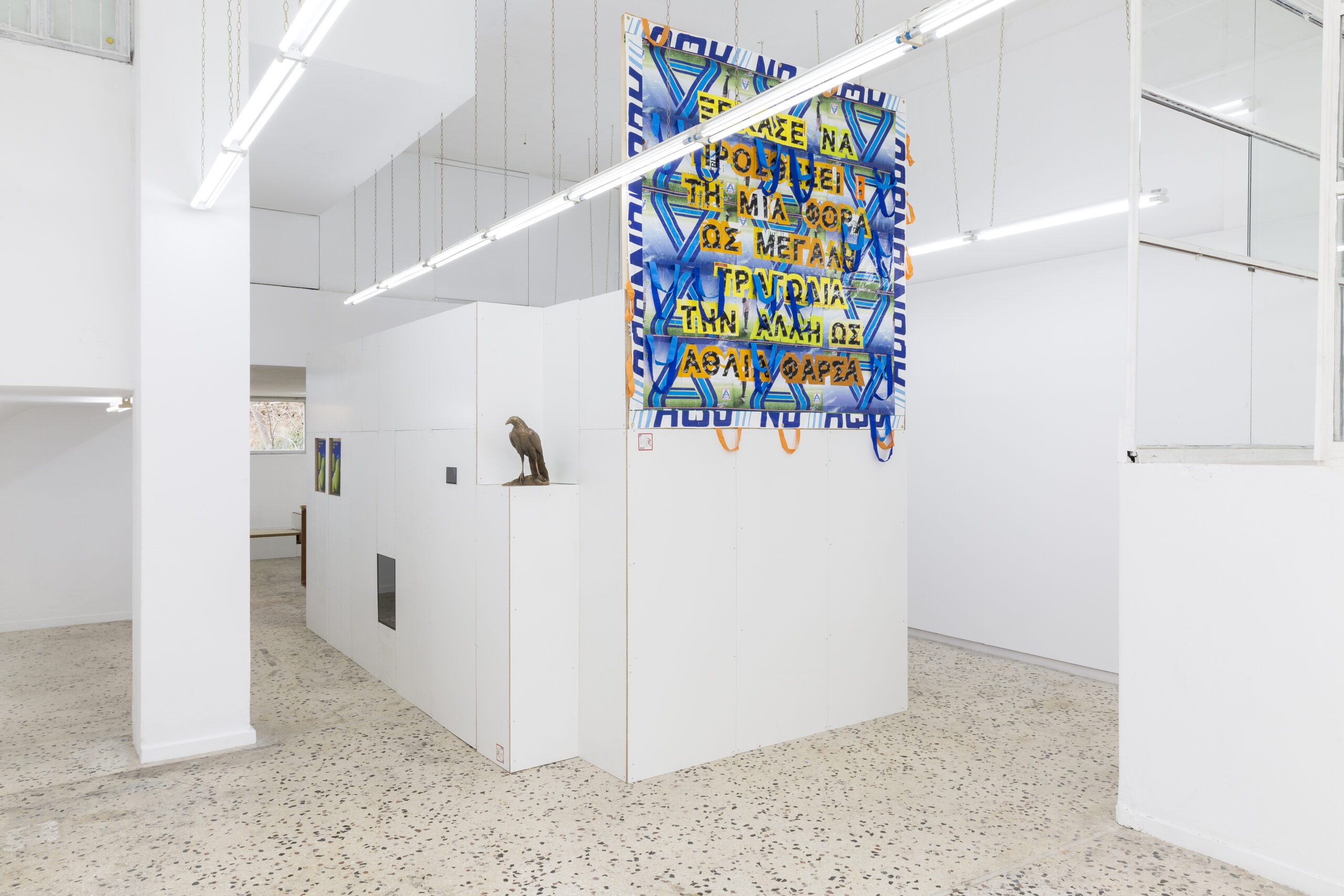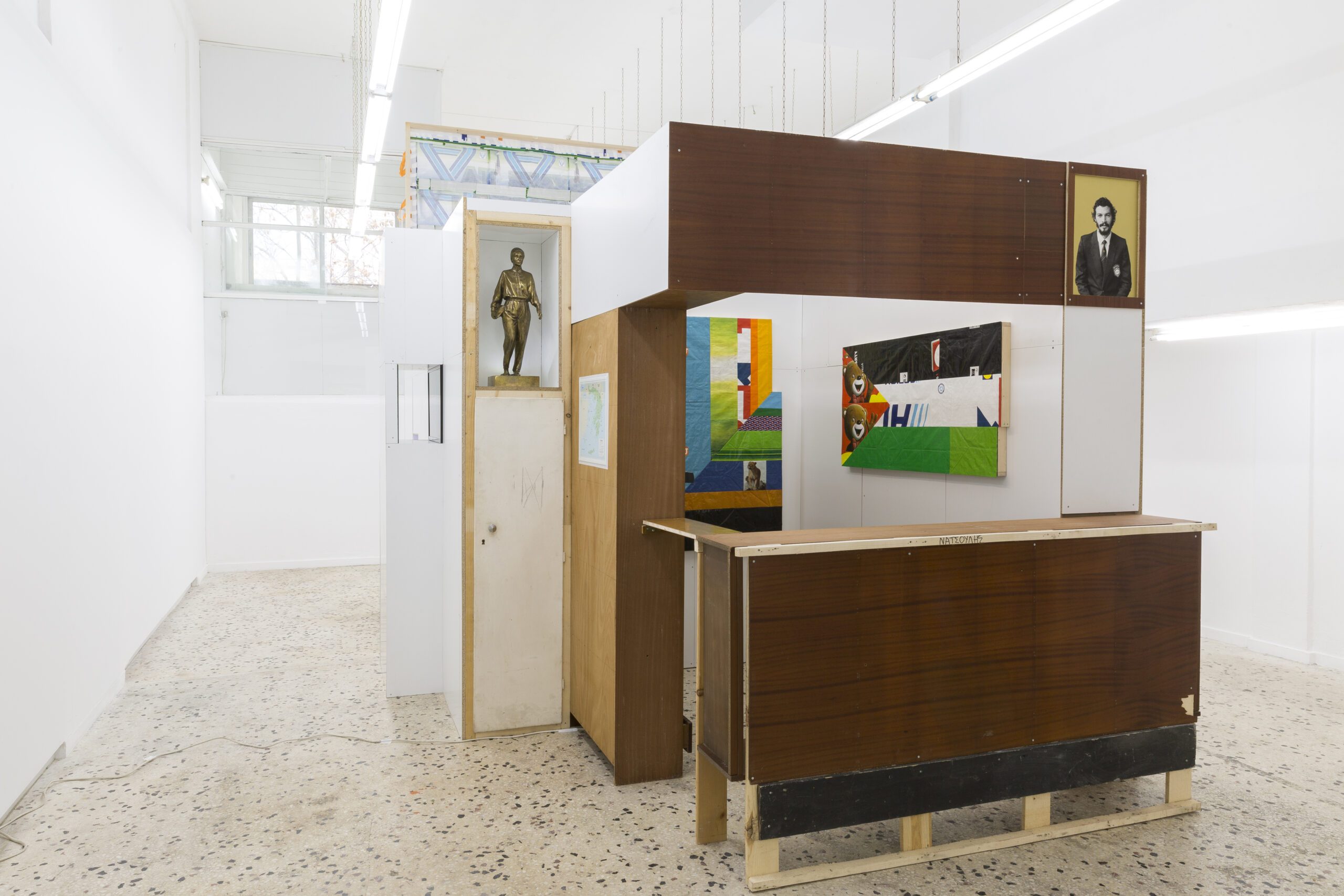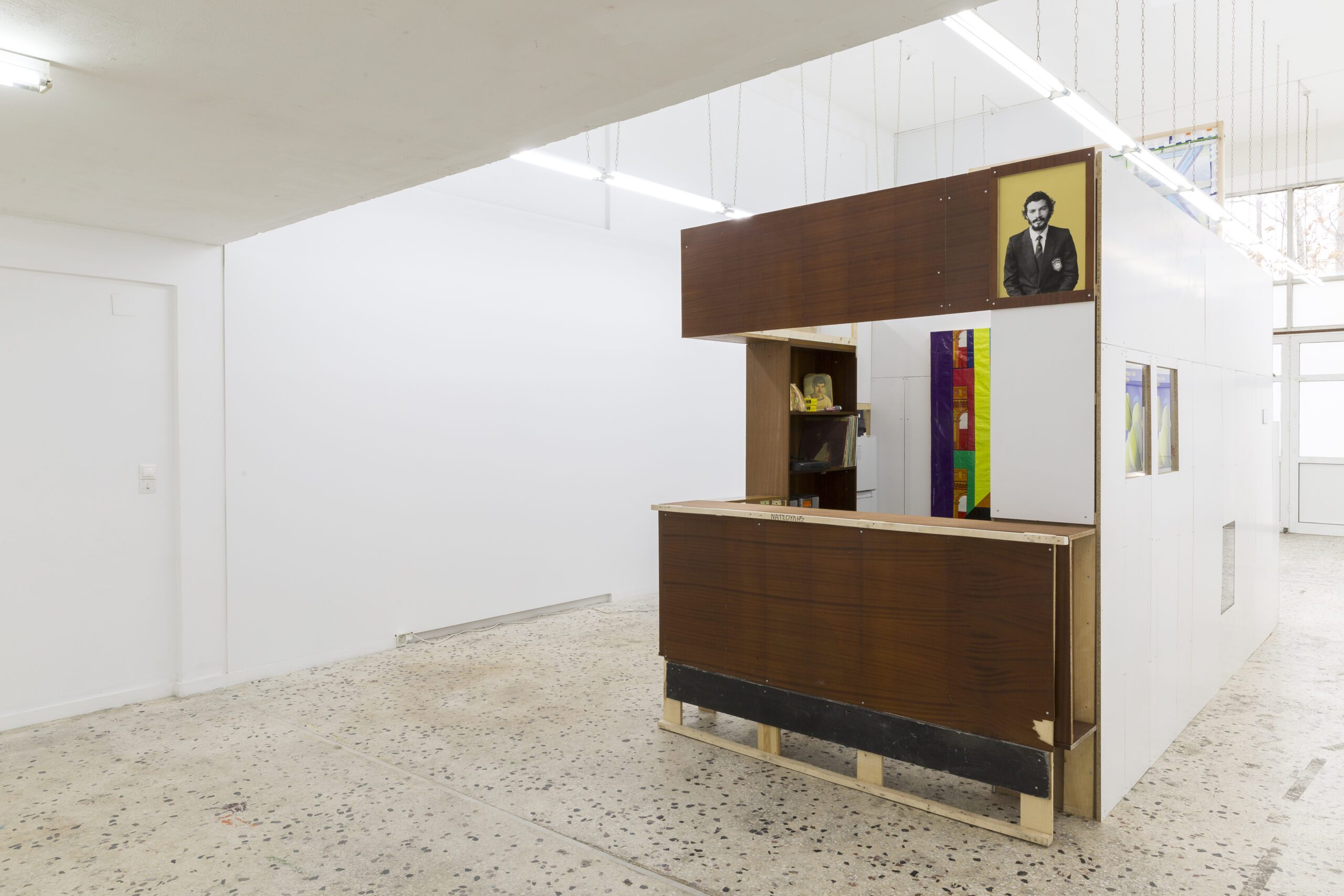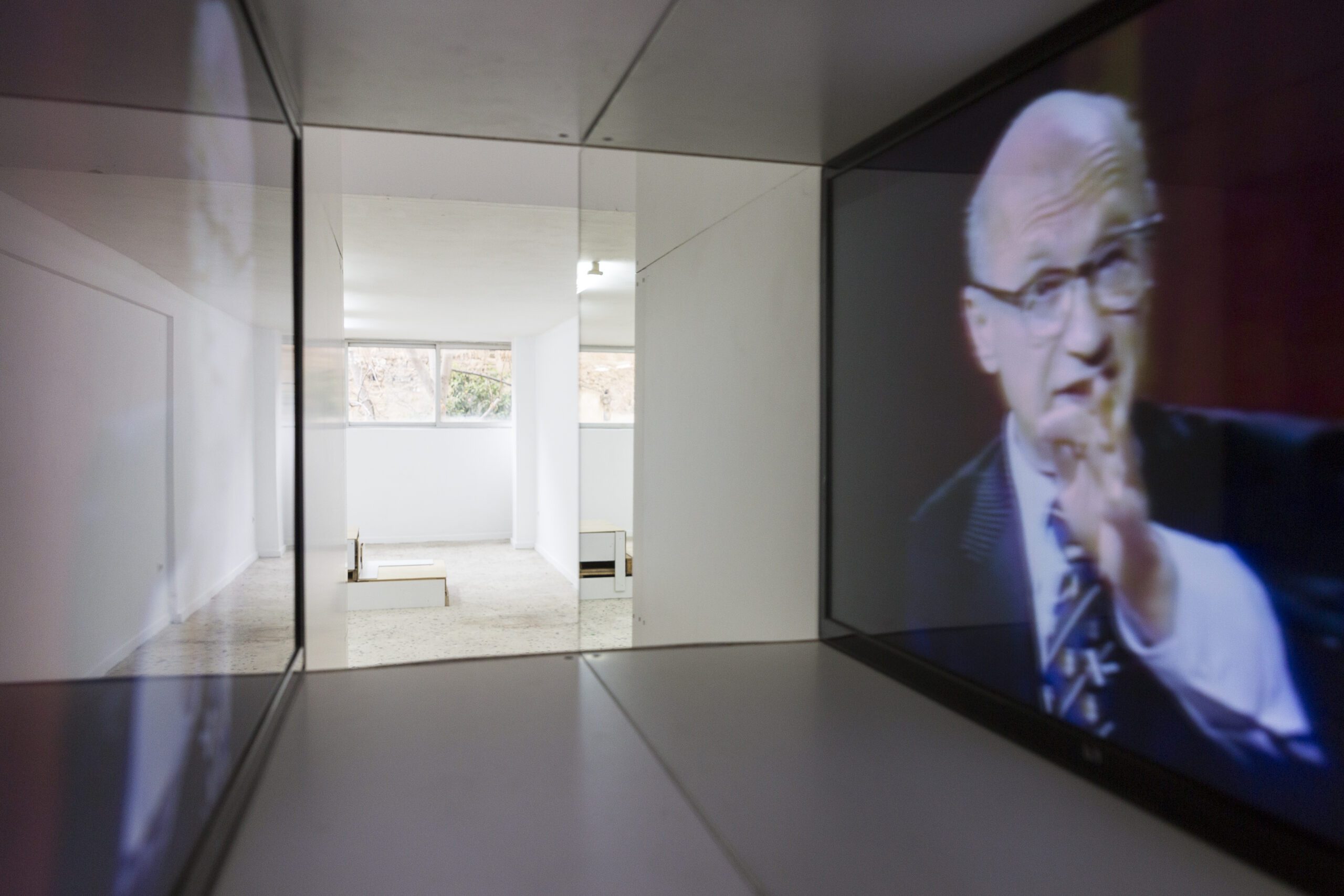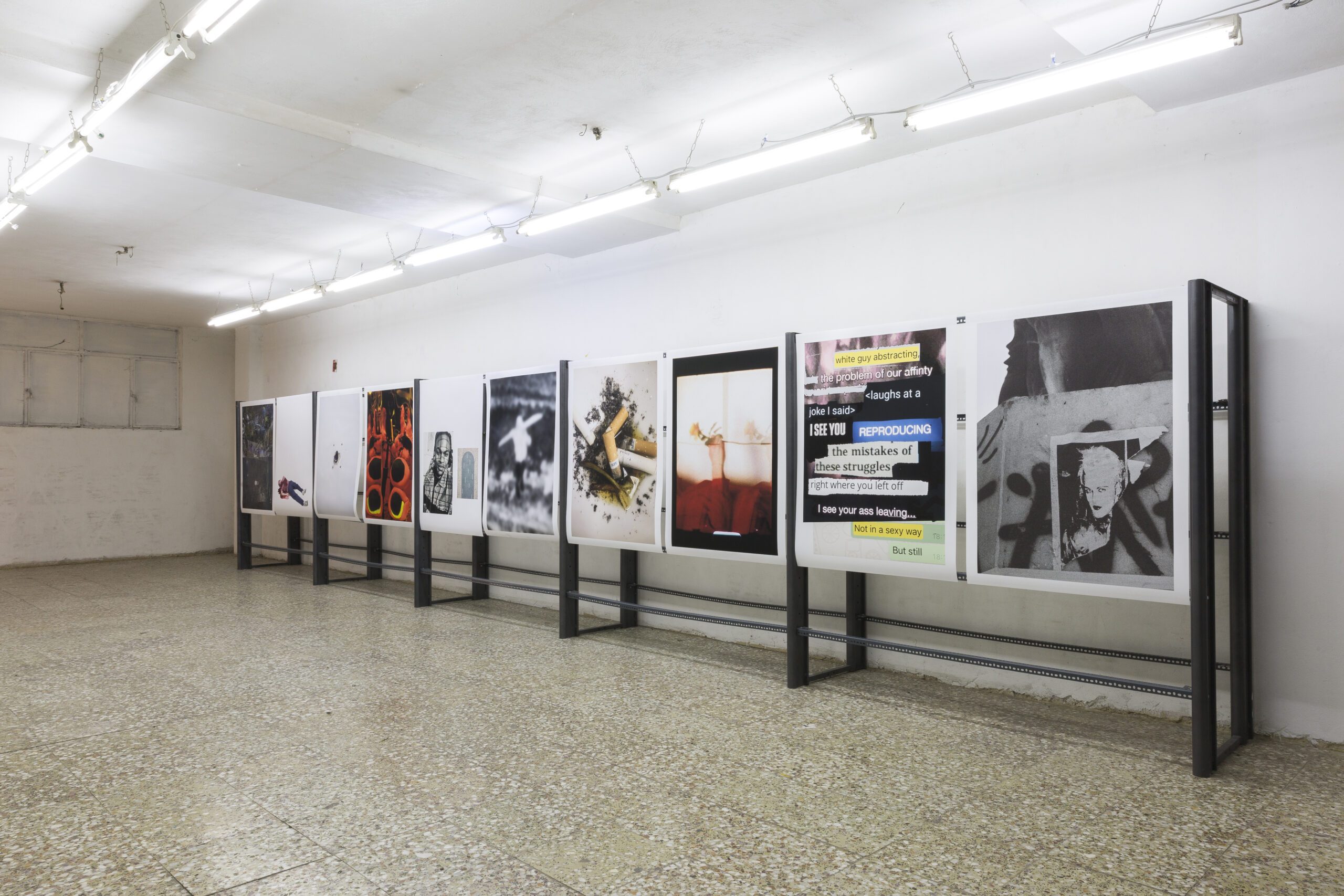PAVILLON / LC X OMS Vol.2
Pavillon
an exhibition
by Matthieu Clainchard and Nicolas Milhé
curated by Nadja Geer
Making of Pavillon
When I invited Nicolas Milhé and Matthieu Clainchard to exhibit in OMS they told me that whatever they were going to build into the space would be both reusable and sourced from the street. Luckily Athens is well known for the wide and rich variety of items that people throw out. The radical negation of the system of value that is manifested through the cycle of consumption and rejection is both counterintuitive and surprising.
The idea to upcycling came together with the conception of building something into OMS – a gallery inside a gallery which could be used to hold art works but which could also be regarded as a sculptural object in itself. Or a site-specific large-scale sculpture. A type of architectural object. An art bar.
The word ‘bar’ itself can have various meanings: On the one hand it can be a counter in a pub, restaurant, or cafe across which drinks or refreshments can be served. On the other hand, ‘bar’ can refer to a long rigid piece of wood, metal, or similar material, typically used in construction as a fastening device. To my mind, though, the word ‘ bar’ refers to the transversal, that cuts across a system of lines.
The last ten days we spent together were all about construction but also about having fun in the process of creating something together. Much time was also spent transporting material from the streets inside or from one space to another. OMS was lucky enough to have the basement as a venue and this was where Matthieu and Nicolas sourced the white plastic veneered chipboard they used for the outer wall of the pavilion.
We discussed in detail the notion of the pavilion as perhaps the most emblematic architectural form for representing art by nationality. The concept behind Pavillon in One Minute Space is to go beyond and above this politics of evaluation and national identity to create an alternative. And because both artists work with the dispositive, we also considered the possibility of subverting the exercise of power within the social body. Georgio Agamben wrote that it is urgent to promote the profanation of the dispositives in order to bring to light the ungovernable, which is at the same time the beginning and the vanishing point of all politics.[1] I personally see a connection here in the way Nicolas works with assemblage and symbols in his Neo Conceptualism. I was especially delighted that he was able to bring “Rosa Luxemburg” (2014) over to Athens, a middle-sized bronze and one out of eight that he produced after winning the Prix MAIF. I loved this sculpture from the first time I saw it and was most impressed by his procedure of re-modeling and production of the figurine. With the ghost of Rosa Luxemburg still haunting the left, it was amazing to see an artist bring her and the Internationale back to life by situating her outside of certain topographies to create a new space of transition.
“As both a political declaration in the public space and the reappropriation of this public space by politics, the work of Nicolas Milhé is an invaluable bulwark against the convention that parch democracy, the form of private appropriation which carve it up, the enslaving effect of money, and the disenchantment too, the democratic fatigue which affects all citizens.”[2]
This “democratic fatigue” that Olivier Christin mentions here in regard to Nicolas’ work was somehow the basis of the narrative that Nicolas and Matthieu brought to the table when we started discussing the exhibition. Our starting question was what “engaging with politics and questioning our current post-utopian condition” could mean? Are we really living in a post-utopian condition and the question that would follow would be – what is a utopian condition? Eden?
For me, it was clear that the discussions circled around the question: What is left? Or where is left? The question of the position of the left in the contemporary global political field. Post-Socialism after 1989, the loss of an alternative, as it was often stated, lead maybe to this form of leftist depression that Mark Fisher described best in his “Capitalist Realism” – this disappointment, especially in the cultural left, that their visions of a better future integrated into their 1960’s artistic production never came to fruition. As Fisher points out: None of these utopian ideas artists, writers, film makers and pop musicians envisioned became reality. The better future is still to come – or might never come at all.
It is a great pleasure for me that Matthieu managed to bring “Covers, UBIK 5&6/10” (2022) to Athens, an under-glass painting of a book cover of the science fiction author Philip K. Dick. The cover of the book shows a stunning design and there is this little difference in this artistic ‘reproduction’ that strikes the eye. Matthieu pointed out that record covers often have a second life as art works or are themselves art works – Peter Blake might be a name to drop here – but also book covers live quite a life in the shadow of content. Giving this side issue a new stage could be seen as part of Matthieu’s artistic methodology next to an amazing eye for detail. The best idea of Postmodernism – dehierachize! – finds its echo in his approach of expanding horizons to such an extent that one cannot help but close the chasm – the chasm between high art and pop, trivial and artistically valuable.
The quotation most of us know that Matthieu Clainchard stitched on Aldi plastic bags takes on a new drama in view of the current world situation. “An History Repeating” (2022), forms for me another transversal across nations, times and politics, shedding a new light on “Chronopolitics”, the impact of time perspectives and on the dynamic of change – the theme of OMS in 2023.
The double meaning of bar – as a social place, a meeting place and a place to consume and also a transversal division, dividing and bringing together anew what was cut up by conventions, is an interesting model to present art. The Pavillon Bar in OMS be will be open every Friday night over the next four weeks.
Many thanks to – Eric Stephany, Florent Frizet, Lola Poustis, Eleonore Brochain, Jules Cartier and Bruno d’Hubert – you’ve all been an amazing help.
[1] Georgio Agamben: Was ist ein Dispositiv? Diaphanes, Zürich-Berlin. 2008, S. 40f.
[2] Olivier Christin, Government of The Many, in: V, Edition Samy Abraham, Le Presses Du reel, Dijon 2017, p. 44.
Text by Nadja Geer
Nicolas Milhé (1976) is an artist living and working in Paris. His practice involves multiple fields of intervention: sculptures, monumental installations, drawings, videos. Nicolas Milhé manipulates the symbolic forms of power to better entrench them in their contradictions and paradoxes, even if he evacuates the idea of a committed work, his work flourishes in the approach of the political fact and the public thing. He has exhibited in France and abroad: The Musée d’art moderne de la Ville, the Centre Pompidou and the Palais de Tokyo, all in Paris; the Villa Bernasconi in Geneva, Komplot in Brussels, the Chiroux Cultural Centre in Liège, Me Collectors Room in Berlin, the San Telmo museum in San Sebastian, Spain, Zoo Gallery in Madrid, Pigna Project Space in Rome, Open Eye Gallery in Liverpool, the Darling Foundry in Montréal, Wonderful Collection in Ho Chi Minh City, the Singapore Biennial, the Old Nagara Post Office in Japan, among others. Nicolas Milhé is a professor at the École Supérieure des Beaux-Arts de Bordeaux.
Matthieu Clainchard (1973) is an artist and curator working and living in Paris. His practice experiments different ways, organizations, and role playing in order to produce art. He likes to modify hierarchies and melt social and technical organization of art and culture. He co-founded LE COMMISSARIAT in 2006, a non-profit gallery in order to develop a practice of curating in a spontaneous and open mode. Exhibitions selection: 2018 Mégapixel, Couloir Hamburg; 2016 É Cosa Mentale, Baby, Curator Studio, Paris; 2014 KUL LE ON HO BAK (duo with Seulgi Lee), Syndicat Potentiel, Strasbourg, 2013; Enorme Changement de Dernière Minute (duo with Nicolas Milhé) Galerie Samy Abraham, Paris; 2012 36 Colors, 9-step Greyscale and 7 Standard Skintones, Les Instants Chavirés, Montreuil, 2010; It’s like a jungle sometimes it makes me wonder how I keep from going under, Problèmes De Type Grec, La Galerie, Centre d’art Contemporain, Noisy-le-Sec (curated by Emilie Renard). Matthieu Clainchard teaches at l’École Supérieure d’Art Annecy Alpes.
———-
LC X OMS Vol.2
Eleni Bagaki, Jean-Damien Charmoille, Florent Frizet, Konstantinos Giotis, Iasonas Kampanis, Katerina Komaniou, Karolina Krasouli, Lapin-Canard, Charlotte Nieuwenhuys, Louis-Philippe Scoufaras, Erica Scourti, Dimitris Tampakis, Iris Touliatou, Paky Vlassopoulou
Curated by Eric Stephany
Lapin-Canard was founded in Paris Belleville on the 1st of May 2015 and does artists’ posters. It offers visual artists it enjoys carte blanche on a single A0 format (840 x 1188 mm). The posters are pigmented inkjet prints on 189g/m2 matt paper. They are released in affordable editions of 10 alongside 1 exhibition print and 1 artist’s proof. The prints are made on demand by Atelier Martin Garanger in Paris. Lapin-Canard is non-lucrative and remits 60% of profits to the artist. Releases are always celebrated with music, libations and dances, in Paris or elsewhere.
